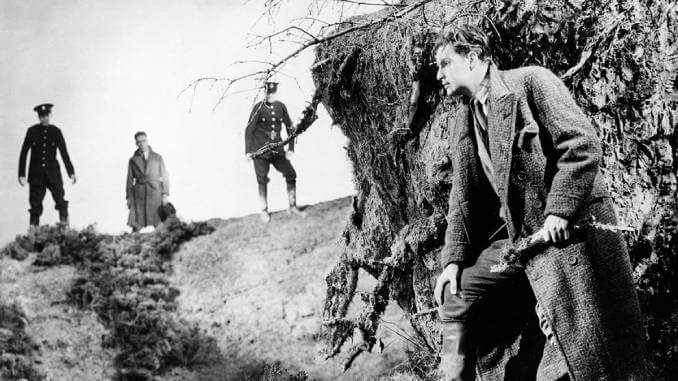The 39 Steps: Alfred Hitchcock’s Fun, Flighty Trial Run of North By Northwest

North By Northwest, Alfred Hitchcock’s 1959 film about an everyday marketing executive (Cary Grant’s Roger Thornhill) embroiled in an international manhunt by foreign spies after an unfortunate case of mistaken identity, is often noted as being heavily influential on the modern action film. It’s tough to argue against, as Hitchcock’s setpiece-forward approach to the film, favoring big moments and clever character banter over intricate plotting or symbolism, would predict many contemporary crowd-pleasing spectacles. The Master of Suspense ended up with a progenitor of the upbeat, globetrotting blockbuster.
However, it doesn’t take too thorough an investigation of his prior catalog to see that he was always building toward a film like North By Northwest. His oeuvre is one full of spy pictures, particularly ones where someone finds themselves in the wrong place at the wrong time, or is thrust into the world of international espionage after they are mistaken for someone they’re not (apt for a director with a film literally called The Wrong Man). The Man Who Knew Too Much, Secret Agent, Foreign Correspondent and Saboteur all intersect with these particular conventions of Hitchcock’s films in one way or another. But the one that feels most in tune with the spirit of North by Northwest and, indeed, makes for an even earlier predecessor of the types of blockbusters seen today is his British-made film The 39 Steps.
As a story about an average man on the run after accidentally being exposed to the taciturn world of undercover agents, The 39 Steps is a familiar, winking piece of pulp from a director who thrived when throwing his audience off-track as much as he did when purely entertaining them. And yes, it’s hard for it not to feel like a dry run of the film that would later be known as one of his masterpieces.
Unlike Thornhill, whom a group of foreign agents pursues after he’s erroneously identified as an opposing spy, The 39 Steps follows Richard Hannay (Robert Donat), a man in London on business who is fleeing the law after being wrongly accused of a murder in his flat. The murdered woman, Annabella Smith (Lucie Mannheim), was an undercover agent whose death actually lies at the hands of operatives from the mysterious 39 Steps spy organization. Having shared intel with Hannay that the men she’s looking for are located in the Scottish highlands, Hannay flees north in order to uncover the outfit and clear his name, experiencing close encounters with both the police and dangerous foreign agents in the process.
Just as North by Northwest was steeped in Cold War paranoia, The 39 Steps is indebted to similar notions of political fears and invading foreign presences. Fitting, as John Buchan’s novel of the same name, on which the film is based, was written at the outset of World War I and deals with the fears of intelligence agents in England and Scotland.
Yet both films also prioritize a gradually escalating sense of adventure, intrigue and fun. In particular, The 39 Steps sees Hitchcock in pulp mode, where his tight, controlled framing and gift for crafting sequences of mounting tension meets a freewheeling sense of episodic incident in which a dopey, ill-equipped guy finds himself flying by the seat of his pants as he tries to outrun the parties closing in on him, all while encasing himself further into a world of peril. Though loosely based on Buchan’s novel, the film deviates from the plot significantly, likely because Hitchcock saw a story he could imbue with his particular flair for impish thrills.
Also like North By Northwest, The 39 Steps’ idea of a globetrotting adventure is limited to a single country. Still, the adventurous capers are infectious as we move from the nightlife of London to the rural moors of Scotland and back again. The 39 Steps is fueled by the conspiracy of words and double-crossings through and through, yet still feels evocative of the blockbuster heroes and feats that we see in cinemas today.
-

-

-

-

-

-

-

-

-

-

-

-

-

-

-

-

-

-

-

-

-

-

-

-

-

-

-

-

-

-

-

-

-

-

-

-

-

-

-

-








































